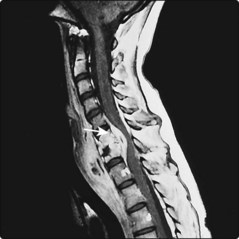Infections of the nervous system II
Spinal infections
Poliomyelitis is now extremely rare. It can lead to a myelitis and leave significant neurological deficit (p. 109).
Pyogenic infection in the vertebral body or in the epidural space can lead to an epidural abscess (Fig. 1), producing back pain often associated with fever. This is followed by radicular pain and then symptoms and signs of spinal cord or cauda equina involvement. If this diagnosis is suspected then urgent investigation with spinal MRI is needed, as early drainage of the abscess and high-dose antibiotics is the only hope of reversing this process. A similar, if slower, onset is associated with tuberculous epidural abscess. Treatment of this is primarily antituberculous therapy, though in some patients surgery is needed.




